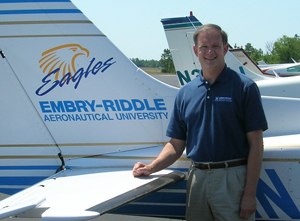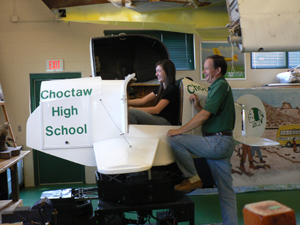After serving for 30 years as a Navy aviator, Leo F. Murphy decided to try his hand at teaching in the civilian world. Today, he oversees aviation programs in five high schools, runs similar courses in elementary and middle schools, and teaches night classes at the undergraduate and graduate levels.
His role in creating an aviation institute program for schools in Okaloosa County, Fla., earned him the Air Force Association’s 2008 National Aerospace Teacher of the Year Award. Murphy is credited with incorporating guest speakers, field trips, and hands-on activities to get his students excited about careers in aviation and aerospace.
 |
Leo Murphy directs Okaloosa County aviation programs. |
“I’m really fortunate because my students are interested in flight, and because of that, we share a common bond,” said Murphy. “They want to be there with us and learn about flying.”
In addition to his teaching, he developed a low-cost, local college degree completion alternative that allows his students to live at home and attend nearby state junior colleges and universities to obtain degrees in aeronautics. He is also a member of the Embry-Riddle Aeronautical University faculty in Daytona Beach, Fla.
He has extensive aviation credentials. After earning his wings at Pensacola, Fla., Murphy served with a P-3 squadron flying the Orion in anti-submarine warfare duty. He served aboard ship and was stationed at bases in Bermuda, Iceland, and Hawaii, and retired as a lieutenant commander.
When Murphy was stationed in Pensacola as director of the Navy’s Aviation Training School, nearing retirement, he decided to get a master’s degree from Embry-Riddle.
Teaching a night school course for the university, he learned of a new aviation program in Okaloosa County. Murphy visited the school and wound up accepting the position as director.
“I was an instructor my whole Navy career,” he said. “From my first squadron on, I was either a ground or flight or simulator instructor and I really enjoyed teaching.”
Murphy noted that the more senior officers become, the more mentoring they tend to do, and he had “plenty of podium time” as well.
The program Murphy signed on for originally was designed for only one high school, Choctawhatchee (commonly shortened to Choctaw) in Fort Walton Beach. About two weeks before school started, however, he was asked to start a second program at Crestview High School, about 30 miles away.
Then, the schools that feed students to the first two were added to the program. Students from Niceville and Fort Walton Beach are bused to Choctaw, while those from Baker and Laurel Hill are brought to Crestview.
The program continued to expand. The second year, the middle school teachers asked for their own program. “So I started a program with middle school students and shortly after that, the elementary school teachers said, ‘What about us?’ ” Murphy recounted. “So I now have elementary, middle, and high school programs, and I also teach night school at Choctaw High School.”
Also offered are both undergraduate and graduate classes, so “we have parents sitting in their children’s classrooms at night working on their bachelor’s or master’s degrees. That means that the whole program now spans elementary through master’s degrees.”
Okaloosa was the first Florida school district to offer a course in unmanned aerial vehicles, flying model aircraft. Students learn to build and program their UAVs.
Murphy credits Cindy Gates, Choctaw principal, with having the vision to support aviation and aerospace education. He also praises his Choctaw mentors—Judy Ring, Judy Kane, and Valerie Chubb—with helping him transition from teaching naval officers to teaching high school students. They told him to cut his syllabus from 15 pages to two.
This year, for the first time, the program began offering a program at Niceville High School as well. Murphy said serving the schools means driving 120 miles a day in some cases.
Murphy’s classrooms are full of models and training aids. Explaining them, Murphy said, “I’m a big scrounger.”
For example, he read in a magazine where someone had obtained and restored a Link Trainer, and he thought that would be nice to have for his courses. Up to that point, he had only seen them in museums, but this professor was using one in an engineering program. Murphy called him, and the professor said they will occasionally pop up on eBay. Then, sure enough, one did show up and Murphy got a grant to buy it. He and his son flew to Cleveland at their own expense and rented a truck to bring it down.
He found a retired engineer at Eglin AFB, Fla., who was able to restore it. The engineer told him he was lucky because the Link ran on vacuum tubes, and younger engineers have never seen one.
There was trouble with the trainer, however. The Link had a bellows arrangement supporting it and, when they put a large high school student into it, the trainer leaned to one side. A former World War II pilot explained that the problem was that the student was considerably heavier than the typical pilot from that era.
Murphy found a second Link, got another grant to buy it, and he and an assisting engineer combined the parts to make the trainer sturdy enough to hold a varsity lineman.
 |
Murphy supervises high school student Kristi Klaburn as she operates the Link Trainer. |
Out in the Field
Another time, Murphy learned that a nearby museum had a large model of the Wright brothers’ first powered airplane, about two-thirds the size of the original Wright Flyer. The model had been built for the centennial celebration of the first flight, and the institution no longer wanted it.
Murphy recruited a couple of the students’ fathers who had helped with projects, and they drove to the museum, disassembled the model, brought it back, and reassembled it. The Wright Flyer now hangs in the Choctaw classroom.
Murphy has seen similar models selling for more than a million dollars.
One of Murphy’s former students, Kevin Yates, spoke to a Choctaw class on his job as a helicopter medic. Not only did he tell about the duty, he brought the crew and helicopter with him to give the students a close-up view.
When he can’t bring aviation into the classroom, Murphy takes his students to where it is happening. Twice a year, he teams with the Young Eagles program of the Experimental Aircraft Association to give his students a field trip to an airport. The EAA group gives young people age 8 to 17 an opportunity to fly in a general aviation airplane.
In 2006, the field trip was to Crestview’s airport, where a friend of Murphy’s brought in a World War II primary trainer, the PT-23. The friend, retired Maj. Jim Jansa, bought the airplane when he was stationed in Maine and flew it on weekends. Jansa had sold the trainer in the early 1950s but found it in a barn on a return trip to Maine years later. Jansa bought it back and restored it.
Murphy said there are three levels of training. “First is a boring lecture from me,” he said. Second is flight simulators. Third is when “you get into a real airplane—and now the classroom is bouncing up and down,” Murphy said. “You should see the looks on their faces when they come off the first airplane flight in their lives.”
Most of Murphy’s courses now fall into the elective category, but he hopes that will change as the classes become more popular. However, there is a lot of competition for students’ time. “High school students’ schedules are getting fuller and fuller,” he said.
Many of his students are interested in technical fields, but many others just want to be pilots. He encourages them to try for an engineering degree or some other broader job qualification.
At the moment, Murphy admits, the aviation field has fallen on hard times. A year ago, he said, Embry-Riddle couldn’t keep its flight instructors because they were moving quickly to other jobs. And airline recruiting has really dropped off.
Meanwhile, it is always difficult to get a military flight slot. Both the Navy and the Air Force have cut back on their pilot requirements.
Murphy’s long-term goal is to see more of his students go to college. About three years ago, he asked how many were going to continue their education. “Only four out of 26 students were going to college, and I couldn’t believe it,” he said. “I was absolutely floored. … It turned out that in most cases, nobody in the home had ever been to college, and they were intimidated by the whole application process.”
That’s when Murphy started a program to encourage more to apply for college. “I picked Embry-Riddle because they have a really easy online application process,” he said. “I got them to waive all the fees so it doesn’t cost the students anything.” Murphy had every student complete the application, and tracked their application progress. “Last year I had over 18 accepted.”
Murphy also instituted a transition program that helps students looking for a lower-cost alternative to navigate a path from their local community college to a four-year university.
Murphy said one of his greatest satisfactions comes when a student rushes to his office waving an acceptance letter from a college, something they previously hadn’t imagined they could achieve.
These success stories happen often enough that Murphy is enjoying himself immensely. He said, “If you’re not having fun,” you’re doing it wrong.